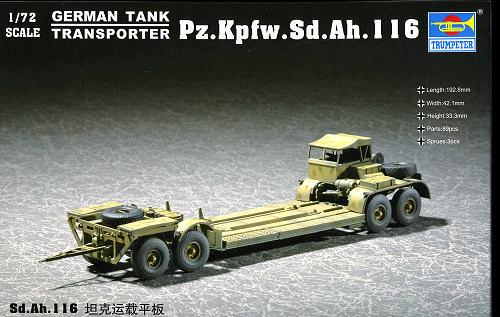
Trumpeter 1/72 Sd.Ah. 116 tank transporter trailer
| KIT: | Trumpeter 1/72 Sd.Ah. 116 tank transporter trailer |
| KIT #: | 07249 |
| PRICE: | $16.98 |
| DECALS: | Three options? |
| REVIEWER: | Scott Van Aken |
| NOTES: | Trailer only. Provide your own prime mover. |

| HISTORY |
The only tank-transporter trailer in common use throughout the greater part of the war was one of 22 to 23-ton capacity, although trailers of 45-tons and 60-tons capacity were developed and standardized - without, however, being encountered in the field. A few specimens of 68-ton trailer for the Tiger II tank were encountered.
The 8- and 10-ton types (mainly used for carrying the light Panzer I/II), both known as Sd.Ah.115, were low loading trailers having a single pair of twin wheels with pneumatic tires at either end. The front axle was arranged for fifth-wheel steering and supported the raised front end of the platform through its loading position on the ground. Ramps could be inserted from the loading platform to the top of the raised front portion enabling the entire trailer to be used as a ramp for loading the tank on to a railway flat or heavy lorry of the Faun L.900 D567 type. The unladen weight of the trailer was 5-tons and the overall length 31 ft, the width 8 ft and the height (unladen) 4 ft 9 in. It was manufactured by Wagen-und Maschinen AG vorm. Busch of Bautzen.
The 22-ton tank-transporter trailer (Sd.Ah.116) - later rated to carry 23-tons - differed from the previous model in having the loading platform suspended between two bogies, each with two pairs of single pneumatic-tired wheels. Both pairs of wheels on the front bogie steered from the draw-bar by means of an arrangement of tie-rods. There was a similar arrangement at the rear, where a light draw-bar was provided for handling the bogie when detached; but in addition, a steering wheel with a compressed-air servo mechanism was provided for the use of an operator required to look after the rear end of the vehicle during travel (the driver of the trailer had to demonstrate driving ability equivalent to that of a holder of a Class 2 driver's license). For raising and lowering the platform, hand-operated winches were used on the earlier models and hydraulic jacks on the later ones. The draw-bar could be locked in the central position. The earlier models were provided with special ramps to enable them to be used for loading railway flats over the front end of the transporter. The unladen weight of the trailer was 11 3/4 -tons, the overall length 45 ft 6 in, the width 9 ft 9 in and overall height (unladen) 8 ft. It was built by Robert Schenk, Waggon-Fabrik, Stuttgart-Feuerbach.
| THE KIT |
 You all know that Trumpeter is involved in all aspects of the plastic model hobby and that includes doing military vehicles. About the only arena they have done poorly in has been that of cars.
You all know that Trumpeter is involved in all aspects of the plastic model hobby and that includes doing military vehicles. About the only arena they have done poorly in has been that of cars.
This particular kit is for the Sd.Ab. 116 22/23 ton trailer. This was sufficient for carrying the Panzer III/IV (though the Panzer IV at 25 tons was a bit of an overload) and vehicles based on those chassis. There are 89 parts on three sprues and there are vinyl/rubber tires. Also included is a length of string and a small chain. Typical of Trumpeter kits, the detailing is excellent. Also typical is the on all the largish parts, there are a myriad of ejector pin marks on one side. Though most will be invisible to those not using IPMS anal lasers, some will not and will require a bit of thought to remove or fill and sand. I also found a couple of sink areas, but none were blatantly obvious and all should be easy to fill and sand. There are no optional parts and you will use all the bits provided in the kit. The string is to be wound around a hoist and the chain is just that; a chain that will be stowed on the flat. 
Instructions are very nicely done and consist of nine well-drawn construction steps. The markings guide uses Gunze paints and depicts one trailer in Panzer yellow with green and brown streaks on it. Apparently this was only built in panzer yellow so your options in terms of painting are limited to that. Of course, this makes painting quite easy if you do not wish to use the camo scheme. A nicely done decal sheet includes the various stencils and warning markings. I guess you have three options in this regard, but the markings guide doesn't differentiate.
| CONCLUSIONS |
These sorts of things are not often modeled and are just as important in the scheme of things as the armor they carried. It is a nice kit, reasonably priced and should provide not only many hours of modeling enjoyment, but a nice way to display one of your panzer builds.
| REFERENCES |
January 2008
Thanks to me and store credit for this one.
If you would like your product reviewed fairly and fairly quickly, please contact the editor or see other details in the Note to Contributors.